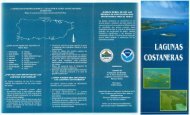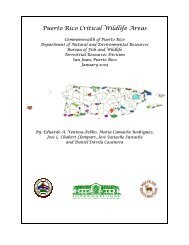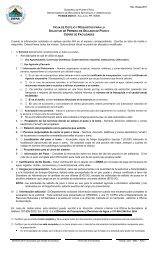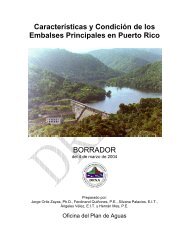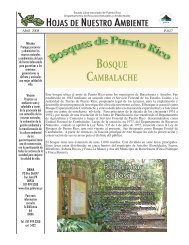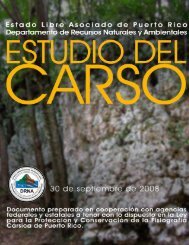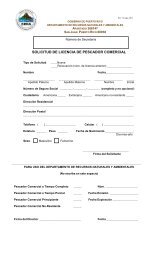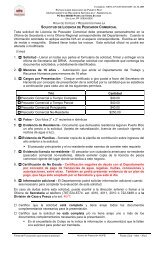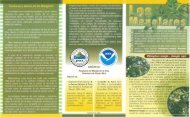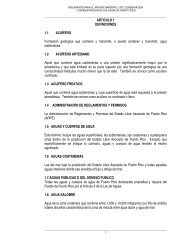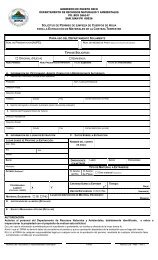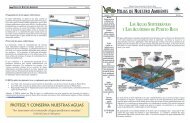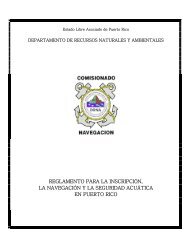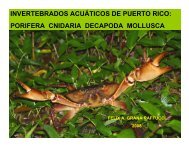determination of the spawning season of bigmouth sleeper
determination of the spawning season of bigmouth sleeper
determination of the spawning season of bigmouth sleeper
You also want an ePaper? Increase the reach of your titles
YUMPU automatically turns print PDFs into web optimized ePapers that Google loves.
were reported from March to December in ano<strong>the</strong>r Costa<br />
Rica study (Winemiller and Ponwith 1998), and from April<br />
through November in Tecolutla estuary in Veracruz, Mexico<br />
(Hernández—Saavedra et al. 2004). Collectively, <strong>the</strong>se findings<br />
suggest near year—round or extended <strong>spawning</strong> periods<br />
in some <strong>bigmouth</strong> <strong>sleeper</strong> populations.<br />
In addition to examination <strong>of</strong> GSI values, plasma or serum<br />
sex steroid concentrations also can be effective in assessing<br />
reproductive development. Hormones such as 17β—estradiol<br />
(estradiol) and testosterone have been used to assess<br />
reproductive development in multiple fish species (Zohar<br />
and Billard 1984, Foster et al. 1993, Holcombe et al. 2000,<br />
Davis et al. 2005, Gross et al. 2006), including members <strong>of</strong><br />
<strong>the</strong> family Eleotridae (Wang et al. 2001). Vitellogenin has<br />
been effective for determining onset <strong>of</strong> sexual maturation<br />
and its continued development in female teleosts, specifically<br />
by using an enzyme—linked immunosorbent assay (ELISA)<br />
(Jackson and Sullivan 1995, Heppell et al. 1999, Gross et al.<br />
2006). Progesterone also has been used with some success to<br />
indicate reproductive maturation in fish (Kagawa et al. 1981,<br />
Nagahama et al. 1991, Foster et al. 1993, Gross et al. 2006).<br />
Evidence <strong>of</strong> natural reproduction in reservoirs, recent<br />
management preferences for native species (Clarkson et al.<br />
2005), and <strong>the</strong> fact that anglers currently target <strong>bigmouth</strong><br />
<strong>sleeper</strong>s for sport and food (Bacheler et al. 2004b) suggest<br />
high potential for this species to serve both sport and food<br />
interests in Puerto Rico and elsewhere. Likewise, declines in<br />
<strong>bigmouth</strong> <strong>sleeper</strong> abundance within its range (Holmquist et<br />
al. 1998, Warren et al. 2000) warrant directed conservation<br />
efforts for this species. If appropriate hatchery propagation<br />
techniques can be developed, supplemental and restoration<br />
stocking could become a viable fisheries management and<br />
conservation tool for <strong>bigmouth</strong> <strong>sleeper</strong>s. However, <strong>spawning</strong><br />
attempts using captive and wild—caught <strong>bigmouth</strong> <strong>sleeper</strong>s<br />
in Puerto Rico have demonstrated minimal success. At<br />
present, <strong>the</strong> major obstacle preventing <strong>the</strong> development <strong>of</strong><br />
appropriate <strong>bigmouth</strong> <strong>sleeper</strong> <strong>spawning</strong> protocols is <strong>the</strong> apparent<br />
lack <strong>of</strong> <strong>season</strong>al reproductive development in captive<br />
specimens <strong>of</strong> reported breeding size (Harris 2007). Thus, to<br />
improve <strong>bigmouth</strong> <strong>sleeper</strong> <strong>spawning</strong> techniques, this study<br />
examined reproductive hormone cycling and reproductive<br />
development for both wild river populations and captive<br />
pond populations in Puerto Rico. This information will be<br />
used to ascertain <strong>the</strong> peak times at which induced <strong>spawning</strong><br />
should be attempted.<br />
MAterIAls And Methods<br />
Study area and fish collections<br />
Three free—flowing rivers in Puerto Rico without significant<br />
instream barriers to fish migration were used as sources<br />
for wild <strong>bigmouth</strong> <strong>sleeper</strong> (Figure 1, Table 1). The Rosario<br />
River, nor<strong>the</strong>ast <strong>of</strong> <strong>the</strong> city <strong>of</strong> Hormigueros, and <strong>the</strong> Nueve<br />
Pasos River, northwest <strong>of</strong> <strong>the</strong> city <strong>of</strong> San Germán, flow into<br />
Harris et al.<br />
<strong>the</strong> Guanajibo River before draining into <strong>the</strong> Mona Passage<br />
south <strong>of</strong> <strong>the</strong> city <strong>of</strong> Mayagüez. The Cañas River drains into<br />
<strong>the</strong> Caribbean Sea on <strong>the</strong> south central portion <strong>of</strong> <strong>the</strong> island<br />
near <strong>the</strong> city <strong>of</strong> Ponce. Fish were collected using a backpack<br />
electr<strong>of</strong>ishing unit using up to 400 volts DC and a 60—Hz<br />
pulse cycle. Due to <strong>the</strong> close proximity, similar physiochemical<br />
and habitat characteristics, and stable tropical water temperatures<br />
(e.g., summer temperatures 24.8—25.9°C; Kwak et<br />
al. 2007) <strong>of</strong> <strong>the</strong>se rivers, <strong>the</strong>y were considered as one sample<br />
population for this manuscript. The amphidromous life history<br />
<strong>of</strong> <strong>bigmouth</strong> <strong>sleeper</strong>s (Holmquist et al. 1998), proximity<br />
<strong>of</strong> <strong>the</strong>se river systems, absence <strong>of</strong> significant in stream barriers<br />
to fish migration, and similar physical and water quality<br />
characteristics <strong>of</strong> <strong>the</strong>se river systems, suggests that population<br />
mixing among <strong>the</strong>se rivers systems is likely to occur.<br />
Captive <strong>bigmouth</strong> <strong>sleeper</strong>s were originally collected at<br />
least one year prior to this study from <strong>the</strong> Cañas, Rosario,<br />
and Nueve Pasos Rivers, and from Carite Reservoir. These<br />
fish were transported to <strong>the</strong> Agricultural Research Station <strong>of</strong><br />
<strong>the</strong> University <strong>of</strong> Puerto Rico—Mayagüez located near Lajas,<br />
Puerto Rico, and held in four 100 m2 ponds with a maximum<br />
depth <strong>of</strong> 1.0 m (summer temperatures 28.1—32.1°C). At least<br />
2 male and 4 female <strong>bigmouth</strong> <strong>sleeper</strong>s were stocked in each<br />
pond. Ponds were stocked with a self—sustaining prey base<br />
<strong>of</strong> mollies Poecilia spp., swordtails Xiphophorus spp., tilapia<br />
Oreochromis and Tilapia spp., and threadfin shad Dorosoma<br />
petenense. Sampling was conducted monthly in conjunction<br />
with sampling <strong>of</strong> wild populations using a standard seine.<br />
Whereas physiological parameters may change with fish size,<br />
<strong>bigmouth</strong> <strong>sleeper</strong> total lengths (TL) were compared using<br />
general linear models (PROC GLM, SAS Version 9.2) with<br />
<strong>the</strong> class variable month, source (wild or hatchery), and sex.<br />
Gonadosomatic index, plasma vitellogenin, and<br />
steroid hormones<br />
Wild <strong>bigmouth</strong> <strong>sleeper</strong> specimens collected from <strong>the</strong><br />
Nueve Pasos, Rosario, and Cañas Rivers between March and<br />
October 2007 were used to determine GSI and hormone<br />
concentrations before, during, and after <strong>the</strong> presumed breeding<br />
<strong>season</strong> (May—June; Bacheler et al. 2004a). Each month,<br />
5—7 females and 3—5 males <strong>of</strong> breeding sizes were collected.<br />
All specimens exceeded <strong>the</strong> reported minimum size at maturity<br />
(159 mm and 179 mm TL for male and female <strong>bigmouth</strong><br />
<strong>sleeper</strong>s, respectively; Bacheler et al. 2004a), and most exceeded<br />
200 mm TL. Fish were measured, weighed (nearest<br />
2.0 g), and euthanized with 150 mg/L <strong>of</strong> tricaine methansulfonate<br />
(MS—222; Argent Chemical Laboratories, Inc.,<br />
Redmond, WA) buffered to pH 7 with sodium bicarbonate.<br />
Blood (1.0—1.5 mL) was taken by insertion <strong>of</strong> a sodium heparin<br />
coated syringe (21 gauge, 38 mm needle) into <strong>the</strong> caudal<br />
vasculature. In cases where blood collection was insufficient,<br />
<strong>the</strong> tail was severed behind <strong>the</strong> posterior dorsal fin and<br />
blood was collected using 470 µL heparinized Caraway tubes.<br />
Blood samples were immediately placed on ice in 1.5 mL<br />
42



